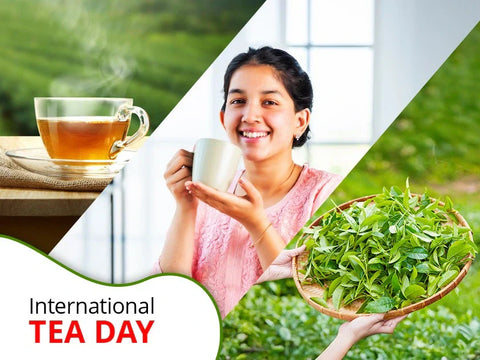Why is International Tea Day celebrated?
Tea lovers across the globe have one more reason to sip their favourite brew with extra love on May 21st—International Tea Day.
But did you know why this day is celebrated?
It’s more than just honoring a beverage—it’s about recognizing tea’s cultural, social, and economic significance, especially for millions of tea workers and small growers around the world.
The Fascinating Origins of Tea: From Ancient Legends to Global Brews
Tea, the second most widely consumed beverage in the world after water, has a history as rich as its taste. But have you ever wondered where and how this humble leaf made its way into our cups? Let’s travel back in time to uncover the origin story of tea.
Tea has a long and interesting history that starts with a famous story from China.
A long time ago, in 2737 BCE, there was an emperor named Shen Nong. He was known for studying plants and herbs.
One day, while he was boiling water under a tree, some leaves from the tree accidentally fell into his pot. When he tasted the water, he found it had a nice smell and made him feel fresh and awake.This lucky accident is believed to be the first time tea was made, and that’s how tea’s story began.
Global Tea Traditions across countries
1. India: Where Chai is an Emotion
In India, tea is not just a beverage – it’s a way of life.
From the first cup of kadak chai in the morning to the evening break at the neighborhood chai Tapri, tea flows through the heart of India’s daily routine.
India’s tea culture is colorful, noisy, flavorful, and deeply emotional. It’s found in the small, bustling streets where chaiwalas serve tea in kulhads (clay cups), in homes where tea is served to every guest as a gesture of love, and in offices where tea breaks turn into bonding moments.
What makes Indian tea special?
-
Masala Chai: Strong black tea made with milk, sugar, and spices such as ginger, cardamom, and cloves.
-
Chai Tapri Culture: Street-side tea stalls where people gather to chat, debate, and bond.
-
More than a beverage: it's a daily ritual of connection, comfort, and warmth
2. Japan: The Art of Tea and Mindfulness
In Japan, tea is not just a drink—it’s an art form rooted in mindfulness, harmony, and respect.
The famous Japanese tea ceremony (Chanoyu) reflects Zen philosophy, where each gesture is thoughtful, precise, and done in silence. The focus is not just on drinking tea but on appreciating the moment.
What makes the Japanese tea tradition unique?
-
The Tea Ceremony (Chanoyu): A centuries-old ritual of preparing and serving matcha (powdered green tea), focusing on grace and mindfulness.
-
Matcha Culture: Beyond the ceremony, matcha is widely enjoyed in daily life through drinks, desserts, and sweets.
-
Zen Connection: Tea drinking in Japan is closely tied to Zen Buddhism, teaching people to slow down and appreciate simplicity.
3. United Kingdom: The Classic Tradition of Afternoon Tea
Tea is more than a drink in Britain – it's a national treasure and a daily ritual wrapped in tradition.
From the comforting ‘builder’s brew’ to the elegant afternoon tea, tea is a symbol of British hospitality, relaxation, and charm.
What makes British tea culture unique?
-
Afternoon Tea Elegance: Introduced in the 1840s by Anna, the Duchess of Bedford, afternoon tea became a fashionable social event, complete with fine china, delicate sandwiches, scones, and, of course, black tea with milk.
-
The Great British Cuppa: For many Brits, tea is essential for starting the day, taking a break, or simply unwinding. Strong builders’ tea (black tea with milk and sugar) is a favourite in working-class communities.
-
Tea and Social Bonding: Whether it's a casual chat over tea or a grand afternoon spread, tea is always about bringing people together.
4. China: The Birthplace of Tea
China is where the story of tea truly begins. With over 5,000 years of tea history, China’s relationship with tea is deeply spiritual, cultural, and artistic.
What makes the Chinese tea tradition special?
-
Legend of Shen Nong: According to ancient folklore, Emperor Shen Nong discovered tea by accident in 2737 BCE, when tea leaves fell into his pot of boiling water.
-
Diverse Tea Varieties: China is home to all major tea types—green, black, white, oolong, and pu-erh—each prepared with care and ceremony.
-
Gongfu Tea Ceremony: A traditional Chinese tea ceremony focused on skill, patience, and precision, using small clay teapots and multiple infusions.
How to Celebrate International Tea Day
Celebrating International Tea Day is simple, personal, and joyful. Here’s how you can make it special:
-
Brew and Savor: Take time to brew your favorite cup of tea and truly enjoy the moment.
-
Learn Something New: Explore the origins of your tea and appreciate the journey from leaf to cup.
-
Try & Share: Experiment with new tea blends and share your tea stories with friends and family.
-
Spread the Love: Join the global celebration online using #InternationalTeaDay
As Frances Hardinge once said
– Frances Hardinge : For me, tea isn't just a drink—it's a way of life. Each sip tells a story.
The Indian Way: Kadak, Masaledar, and Full of Emotion
In India, tea is not just a beverage—it’s an emotion served in a cup.
Be it the kadak (strong) chai that wakes us up, the masaledar (spiced) chai that comforts us on rainy days, or the shared tea moments with friends and strangers—every sip of Indian tea carries stories, warmth, and a bit of drama.
Kadak Chai: A Bold Wake-up Call
For Indians, tea is not complete unless it is strong and rich. Strong tea gives us the energy to start the day, face challenges and keep moving forward..
Masaledar Chai: A Hug in a Cup
Add ginger, cardamom, cloves, and cinnamon, and you have masala chai—India’s famous comfort drink that not only warms the body but also the heart.
Chai is a Connection : from street-side chai Tapris to family living rooms, tea is at the center of conversations, celebrations, and pauses.
It’s where laughter brews, arguments cool down, and friendships get stronger—because in India, every cup of tea comes with a side of emotion.
A Cup That Brings People Together
From China's delicate green tea to Britain's refined afternoon tradition, from India's spiced masala chai to Morocco's refreshing mint blend—every culture has its own cherished way of enjoying tea.
But no matter where you are, tea always brings people together. It’s about sharing stories, spending time with loved ones, and finding comfort in a warm cup.
This International Tea Day, let’s raise a cup that feels like home, wherever you are in the world.
Frequently Asked Questions (FAQ)
Q. Why do different cultures have such unique tea rituals?
Tea rituals across cultures reflect each society's history, values, and social customs. For instance, Japan's Chanoyu emphasizes mindfulness and harmony, rooted in Zen Buddhism. In contrast, India's chai culture is informal and communal, often enjoyed at street-side stalls, reflecting warmth and hospitality . These diverse practices showcase how tea serves as a medium for connection and cultural expression worldwide.
Q. Why is International Tea Day celebrated?
International Tea Day, observed on May 21st, was established by the United Nations to recognize tea's cultural, economic, and social significance globally. The day aims to promote sustainable production and consumption of tea and raise awareness about its role in combating hunger and poverty .
Q. How did chai become India’s favourite beverage?
Chai became integral to Indian culture during British colonial rule when the British promoted tea consumption in India. Indians adapted it by adding spices, milk, and sugar, creating masala chai. Over time, chai became a daily staple, enjoyed across the country in homes and at street-side stalls, symbolizing warmth and community.
Q. What are some famous tea ceremonies around the world?
Several cultures have distinctive tea ceremonies:
-
India: Masala chai is a daily ritual, with chaiwalas serving spiced tea across the country.
-
Japan: The Chanoyu ceremony involves the ceremonial preparation of matcha, emphasizing aesthetics and mindfulness.
-
China: The Gongfu tea ceremony focuses on the artful brewing of tea, highlighting precision and appreciation of flavor.
-
Morocco: Mint tea is poured from a height to create foam, symbolizing hospitality.
-
Russia: The Zavarka tradition uses a samovar to brew strong tea, often accompanied by sweets and jams.
-
Turkey: Tea is brewed in a double teapot and served in small glasses, integral to social gatherings.
Q. Which countries consume the most tea?
As of 2024, the top tea-consuming countries per capita are:
-
Turkey
-
Morocco
-
Ireland
-
Mauritania
-
United Kingdom
Turkey leads with an average consumption of 16.6 pounds per person annually, highlighting tea's central role in Turkish culture




